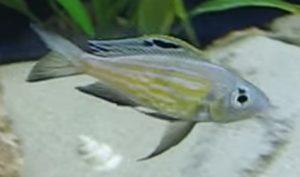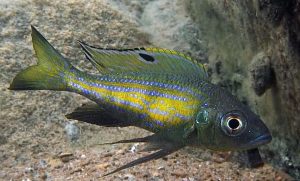Aulonocranus dewindti is a species of “featherfin” cichlid that inhabit sandy bottom areas that are littered with rocks and empty shells in Lake Tanganyika, the Rusisi, and the Lukuga rivers.
Aulonocranus dewindti is endemic to and widely distributed throughout the Lake Tanganyika basin in the Democratic Republic of the Congo, Tanzania, and Zambia.
Aulonocranus dewindti are semi pelagic species that roam over sandy bottom areas of the Lake that are dotted with rocks and empty shells commonly referred to as “intermediate habitat”, where they feed on insect larvae, drifting plankton, and a variety of small crustaceans that hide in the sand. They frequently occur in schools of several hindered fish.
Aulonocranus dewindti have a silvery body color that in males is marked with yellow longitudinal stripes. They have a moderately elongated and compressed body shape, with a length that is approximately three times the height of the body.
They are called “featherfins” because of their long filamentous ventral fins that in adult males, reach to the anal fin. Their caudal fins are crescent shaped.
Several color varieties occur and are dependent on locale.,
In addition to their two lateral lines, Aulonocranus dewindti have developed enlarged sensory pores on their heads that help them detect the plankton, insect larvae, and small crustaceans that they feed on under the sand. Their lower triangularly shaped, slightly protruding lower jaw bone has two to three rows of small, conical teeth that assist them in their foraging.
Aulonocranus dewindti are best kept in an aquarium of at least 65 gallon capacity with a sand or very fine gravel substrate and plenty of shells, crushed corals and small rocks. Featherfin cichlids are best kept in a single species tank, and although several males can be housed in the same aquarium if it is large enough, it’s best to keep a small harem of females for a single male.
In large tanks, several males can be kept together as long as at least three females are provided for each male, there are plenty of hiding places, and plenty of rocks, coral, shells, or even flowerpot pieces are provided for the males to create nests.
A good filtration system and weekly 25% to 35% water changes is required to maintain water quality for this species and a large capacity wet/dry and/or canister filtration system with a powerhead or two is highly recommended to keep these cichlids healthy.
Aulonocranus dewindti are maternal mouth brooders that are relatively easy to breed in an aquarium environment provided good water quality is maintained and a few tips are adhered to.
If the breeding aquarium is large and well decorated with an abundance of hiding places and nest building materials, a couple males can be kept with 6 or 7 females. Although this is not a scientific ratio, it does minimize excessive aggression from a single dominant male. A dominant male can harass females and submissive males to the point of death, and keeping more than one male in the tank will usually focus part of the dominant male’s attention on the other male and give the females a break.
Because Aulonocranus dewindti are nest builders, it is important to have a lot of building materials in the breeding tank. Rocks, pieces of coral, shells, pieces of flowerpots, and flowerpots should be placed in the tank. In the wild, adult males will set up breeding colonies to try to attract females and the males that build the most impressive nests usually get the female.
If you provide Aulonocranus dewindti with a suitable environment, nature will take over and the fish will take care of the rest on their own. Generally, several females can be brooding their young simultaneously in the same tank without any problems.
Most tropical fish keeping enthusiasts allow the offspring to remain with the adults in the aquarium until their mother grows tired of them and wants to spawn again, but you can force brooding females to spit out the fry into a rearing tank filled with the same aquarium water as the breeding tank. Regardless of which method is used, the female should be allowed to brood her fry for at least 10 days. This allows the highest survival rate for the fry.
The fry can be immediately fed newly hatched brine shrimp and/or crushed flake food. When raised on a balanced high protein diet, they will grow quickly should be about 1″ long in about a month or so.
In the wild Aulonocranus dewindti feed on small crustaceans, dipterans, and sand fly larvae. In an aquarium environment, they do well on a balanced diet of live, frozen or freeze dried bloodworms, brine shrimp, Daphnia, mosquito larvae, mysis shrimp, cyclops, cichlid flakes
, cichlid pellets, and an algae based food like spirulina flakes
. A varied diet will prevent nutritional deficiencies.
Aulonocranus dewindti are available to tropical fish keeping enthusiast through cichlid forums, breeders, specialty tropical fish shops, importers, and online auction sites when they are 1 1/2″ size to breeding size paired adults.
Minimum Tank Size: 65 gallons
Care Level: Moderately difficult
Temperament: Mildly Aggressive
Aquarium Hardiness: Moderately hardy
Water Conditions: 76-80° F, H >120 ppm, pH 8.6
Max. Size: Males 4.5″
Color Form: Silver, Yellow
Diet: Omnivore
Compatibility: Single species
Origin: Lake Tanganyika, Africa
Family: Cichlidae
Lifespan: 8-10 years
Aquarist Experience Level: Advanced





